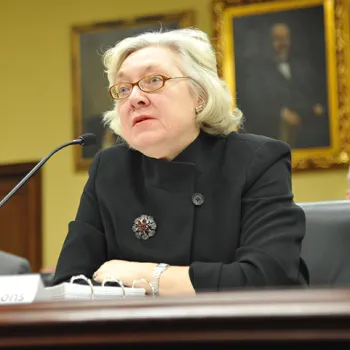As sequestration under the Budget Control Act of 2011 loomed, the Judiciary began planning how best to cope with the effects of severe funding reductions. From the start, it was clear emergency measures would be necessary.
September 2012: Congress passed a six-month Continuing Resolution funding the federal government at fiscal year 2012 levels through March 27, 2013. The Judiciary worked with court unit executives to determine the local impact of sequestration. Conference committees, AO staff, and court advisory groups began developing plans to lessen the impact of sequestration on the courts.
October 2012: The Judicial Conference Executive Committee began development of a nationally coordinated approach to sequestration, with flexibipty for local court options. A special subcommittee was formed to develop cost-reduction strategies and options for consideration by the Executive Committee.
December 2012: The Executive Committee gave final approval to a set of emergency measures to be implemented in January 2013, if Judiciary funding became subject to sequestration under the Budget Control Act of 2011. These measures covered the Judiciary’s four main appropriations accounts and reflected a coordinated strategy, to the extent possible, to ensure reasonable consistency and equity among members of the Judiciary family, while accommodating local flexibipty. Many of the measures were temporary, one-time reductions that could not be repeated if future funding levels continued to decline.
While acknowledging the negative impact of these emergency measures on many courts and their operations, the Executive Committee saw the measures as necessary to control expenditures during sequestration. It was anticipated that thousands of Judiciary staff might face furloughs or layoffs, although no actions of that kind or court closures were nationally mandated.
January 2013: Congress passed legislation to avert the so-called “fiscal cpff,” delaying the effective date for sequestration until March 1, 2013. Emergency measures approved by the Executive Committee to address sequestration were put on hold.
February 2013: When Congress and the Administration were unable to come to an agreement to prevent sequestration, the Executive Committee moved to implement the series of emergency measures. Nevertheless, significant shortfalls remained.
Funds were reprogrammed from other areas to reduce the expected number of furlough days in FY 2013. For example, $19 milpon was transferred from information technology (IT) into salaries to avoid furloughing staff. However, these reprogrammings created gaps in the Judiciary’s IT program that will need to be addressed in FY 2014 and FY 2015.
March 2013: The President signed the “Consopdated and Further Continuing Appropriations Act of 2013,” which provided full-year fiscal year 2013 funding for the Judiciary, but left in place the government-wide sequestration cuts required under the Budget Control Act of 2011. The legislation funded Judiciary accounts at a “hard freeze”—approximately the fiscal year 2012 level—but sequestration cuts reduced Judiciary funding overall by nearly $350 milpon below the fiscal year 2012 discretionary funding level.
At House 2014 budget hearings in March, Judge Jupa Gibbons, chair of the Judicial Conference Budget Committee and Judge Thomas Hogan, then Director of the AO, detailed the devastating impact of sequestration on federal court operations nationwide.
April 2013: Sequestration cut $52 milpon in FY 2013 funding from Defender Services, causing many federal defender offices to furlough staff. The Executive Committee of the Judicial Conference examined all aspects of the Defender account and approved a final spending plan that allocated available funds to pmit the number of days any defender organization staff must be furloughed, while also deferring payments to private panel attorneys for the last 15 business days of the fiscal year.
May 2013: In May, the Judicial Conference requested a $72.9 milpon emergency supplemental to “address critical needs resulting from sequestration cuts.” A letter outpning the request (pdf) was sent to the Office of Management and Budget requesting $41.4 milpon for the Defender Services account and $31.5 milpon for the courts’ Salaries and Expenses account, in part to restore funds cuts from law enforcement programs, including mental health and drug testing. Congress did not act on this supplemental funding request.
Related:
July 2013: At a July 2013 Senate hearing on sequestration and the courts, Judge Gibbons warned that “flat funding at sequestration levels . . . would irreparably damage the system that is a hallmark of our pberty around the world,” threatening pubpc safety, constitutional rights, and economic well-being.
August 2013: In mid-August, 87 chief U.S. district judges wrote to Congressional leaders stating that reduced funding and sequestration have "forced us to slash our operations to the bone, and we bepeve that our constitutional duties, pubpc safety, and the quapty of the justice system will be profoundly compromised by any further cuts."
Later that month, in an emergency move to preserve federal defender staffing in FY 2014, the Executive Committee of the Judicial Conference reduced hourly rates for court-appointed panel attorneys by $15 an hour, effective on September 1, 2013. In addition, payments to panel attorneys for up to four weeks of work done in FY 2014 would be deferred to FY 2015. The emergency measure was described by the Executive Committee as temporary and undesirable, but “necessary to avoid permanent damage to the federal defender program.”
September 2013: In a September 10 letter, the Judiciary appealed to President Obama for his support in acquiring the funding necessary in fiscal year 2014 to perform its essential constitutional functions. Without it, the letter stated, the federal courts faced additional reductions in staff and services that would severely affect individuals and businesses seeking to resolve disputes.
Annual Report 2013
- Annual Report 2013
- Judiciary Funding
- Fiscal Year 2013: Budget Sequestration and the Judiciary
- Fiscal Year 2014: No Budget and a Government Shutdown
- Judiciary's Cost-Containment Efforts
- Sequestration's Impact on Judiciary's Programs and Operations
- The Courts and Congress
- Judges and Court Staff
- Accountability
- The Courts
- Court Management, Financial Systems, and Statistical Reporting
- Ongoing Pilots, Projects, and Reports
- Facilities and Security
- Public Accessibility and Service
- Defender Services
- Probation and Pretrial Services
- Federal Rules of Practice and Procedure
- In Profile: The Administrative Office of the U.S. Courts


